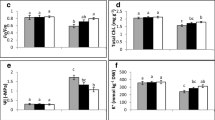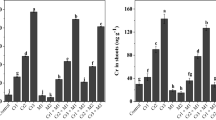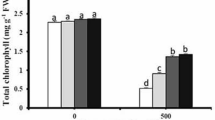Abstract
Application of signaling molecules has gained immense importance in improving the phytoremediative capacity of plants. This study investigated the possible role of melatonin (MEL) as a signaling molecule in ameliorating lead (Pb)-induced oxidative injury in safflower seedlings. Pot grown 10-day-old safflower seedlings were exposed to 50 μM Pb (NO3)2 alone and in combination with different MEL concentrations (0–300 μM). Exposure to Pb, resulted in a severe oxidative stress, which was indicated by reducing biomass production and enhancing the level of oxidative stress markers (e.g. MDA and H2O2). Addition of exogenous MEL considerably decreased Pb uptake and its root-to-shoot translocation while, biomass production of roots, stems and leaves increased significantly. With MEL application a marked increase in reduced glutathione (GSH) content in leaves and roots was noted as compared with Pb treatment alone. In leaves the activity of enzymes involved in glyoxalase system increased markedly by adding MEL to Pb-sressed plants. In response to increasing MEL treatments, the phytochelatin content of leaves increased substantially in comparison with Pb treatment alone. These findings confirmed that MEL can alleviate Pb toxicity by reducing Pb uptake and its root-to-shoot translocation along with modulating different antioxidant systems. The results also showed that despite the insignificant effect of melatonin on the improvement of Pb phytoremediation potential, the application of this signaling molecule can improve the survival of safflower in Pb-contaminated soils by stimulating antioxidant defense mechanisms.




Similar content being viewed by others

References
Aebi H (1984) Catalase in vitro. Method Enzymol 105:121–126
Anderson ME (1985) Determination of glutathione and glutathione disulfide in biological samples. Methods Enzymol 113:548–554
Angelova VR, Perifanova-Nemska MN, Uzunova GP, Kolentsova EN (2016) Accumulation of heavy metals in safflower(Carthamus tinctorius L.). Int J Biol, Biomolecular, Agric, Food Biotechnological Eng 10(7):410–415
Arnon DI, Hogland DR (1940) Crop production in artificial solutions and in soils with special references to factors influencing yields and absorption of inorganic nutrients. Soil Sci 50:463–484
Beauchamp C, Fridovich I (1971) Superoxide dismutase: improved assays and an assay applicable to acrylamide gels. Anal Biochem 44:276–287
Bradford MM (1976) A rapid sensitive method for the quantification of microgram quantities of protein utilizing the principle of protein-dye binding. Anal Biochem 72:248–254
Cui G, Zhao X, Liu S, Sun F, Zhang C, Xi Y (2017) Beneficial effects of melatonin in overcoming drought stress in wheat seedlings. Plant Physio Biochem 118:138–149
Gill SS, Tuteja N (2010) Reactive oxygen species and antioxidant machinery in abiotic stress tolerance in crop plants. Plant Physiol Biochem 48:909–930
Hasan MK, Ahammed GJ, Yin L, Shi K, Xia X, Zhou Y, Yu J, Zhou J (2015) Melatonin mitigates cadmium phytotoxicity through modulation of phytochelatins biosynthesis, vacuolar sequestration, and antioxidant potential in Solanum lycopersicum L. Front Plant Sci 6:601
Hasanuzzaman M, Fujita M (2013) Exogenous sodium nitroprusside alleviates arsenic-induced oxidative stress in wheat (Triticum aestivum L.) seedlings by enhancing antioxidant defense and glyoxalase system. Ecotoxicology 22:584–596
Heath RL, Packer L (1968) Photoperoxidation in isolated chloroplasts. I. Kinetics and stoichiometry of fatty acid peroxidation. Arch Biochem Biophys 125:189–198
Hossain MA, Fujita M (2010) Evidence for a role of exogenous glycinebetaine and proline in antioxidant defense and methylglyoxal detoxification systems in mung bean seedlings under salt stress. Physiol Mol Biol Plants 16:19–29
Kastori R, Plesničar M, Sakač Z, Panković D, Arsenijević-Maksimović I (1998) Effect of excess lead on sunflower growth and photosynthesis. J Plant Nutr 21(1):75–85
Kazemi N, Khavari-Nejad RA, Fahimi H, Saadatmand S, Nejad-Sattari T (2010) Effect of exogenous salicylic acid and nitric oxide on lipid peroxidation and antioxidant enzyme activities in leaves of Brassica napus L. under nickel stress. Sci Hortic 126:402–407
Li S, Zhang G, Gao W, Zhao X, Deng C, Lu L (2015) Plant growth, development and change in GSH level in safflower (Carthamus tinctorius L.) exposed to copper and lead. Arch Biol Sci 67(2):385–396
Lichtenthaler HK (1987) Chlorophylls and carotenoids: pigments of photosynthetic biomembranes. Method Enzymol 148:350–382
Mishra S, Jha AB, Dubey RS (2011) Arsenite treatment induces oxidative stress, upregulates antioxidant system, and causes phytochelatin synthesis in rice seedlings. Protoplasma 248:565–577
Mishra S, Srivastava S, Tripathi RD, Govindarajan R, Kuriakose SV, Prasad MNV (2006) Phytochelatin synthesis and response of antioxidants during cadmium stress in Bacopa monnieri L. Plant Physiol Biochem 44(1):25–37
Molina AS, Nievas C, Chaca MVP, Garibotto F, Gonzalez U, Marsa SM, Luna C, Gimenez MS, Zirulnik F (2008) Cadmium-induced oxidative damage and antioxidative defense mechanisms in Vigna mungo L. Plant Growth Regul 56:285–295
Mostofa MG, Fujita M (2013) Salicylic acid alleviates copper toxicity in rice (Oryza sativa L.) seedlings by up-regulating antioxidative and glyoxalase systems. Ecotoxicology 22(6):959–973
Nakano Y, Asada K (1987) Purification of ascorbate peroxidase in spinach chloroplasts; its inactivation in ascorbate-depleted medium and reactivation by monodehydroascorbate radical. Plant Cell Physiol 28(1):131–140
Namdjoyan S, Kermanian H, Soorki AA, Tabatabaei SM, Elyasi N (2017) Interactive effects of salicylic acid and nitric oxide in alleviating zinc toxicity of safflower (Carthamus tinctorius L.). Ecotoxicology 26:752–761
Namdjoyan S, Namdjoyan S, Kermanian H (2012) Induction of phytochelatin and responses of antioxidants under cadmium stress in safflower (Carthamus tinctorius L.) seedlings. Turk J Bot 36(5):495–502
Namdjoyan SH, Khavari-Nejad RA, Bernard F, Nejad-Sattari T, Shaker H (2011) Antioxidant defense mechanisms in response to cadmium treatments in two safflower cultivars. Russ J Plant Physiol 58:403–413
Noctor G, Mhamdi A, Chaouch S, Han YI, Neukermans J, Marquez-Garcia B, Queval G, Foyer CH (2012) Glutathione in plants: an integrated overview. Plant Cell Environ 35(2):454–484
Polle A, Otter T, Seifert F (1994) Apoplastic peroxidases and lignification in needles of Norway spruce (Picea abies L.). Plant Physiol 106(1):53–60
Posmyk MM, Kuran H, Marciniak K, Janas KM (2008) Presowing seed treatment with melatonin protects red cabbage seedlings against toxic copper ion concentrations. J Pineal Res 45:24–31
Pourrut B, Shahid M, Dumat C, Winterton P, Pinelli E (2011) Lead uptake, toxicity, and detoxification in plants. Rev Environ Contam Toxicol 213:113–136
Principato GB, Rosi G, Talesa V, Giovannini E, Uotila L (1987) Purification and characterization of two forms of glyoxalase II from the liver and brain of Wistar rats. Biochem Biophys Acta 911:349–355
Rossato LV, Nicoloso FT, Farias JG, Cargnelluti D, Tabaldi LA, Antes FG, Dressler VL, Morsch VM, Schetinger MRC (2012) Effects of lead on the growth, lead accumulation and physiological responses of Pluchea sagittalis. Ecotoxicology 21(1):111–123
Sarafi E, Tsouvaltzis P, Chatzissavvidis C, Siomos A, Therios I (2017) Melatonin and resveratrol reverse the toxic effect of high boron (B) and modulate biochemical parameters in pepper plants (Capsicum annuum L.). Plant Physiol Biochem 112:173–182
Seth CS, Remans T, Keunen E, Jozefczak M, Gielen H, Opdenakker K, Weyens N, Vangronsveld J, Cuypers A (2012) Phytoextraction of toxic metals: a central role for glutathione. Plant Cell Environ 35(2):334–346
Sharma A, Shahzad B, Kumar V, Kohli SK, Sidhu GPS, Bali AS, Kapoor D, Bhardwaj R, Zheng B (2019a) Phytohormones regulate accumulation of osmolytes under abiotic stress. Biomolecules 9(7):285
Sharma A, Shahzad B, Rehman A, Bhardwaj R, Landi B, Zheng B (2019b) Response of phenylpropnoid pathway and the role of polyphenols in plants under abiotic stress. Biomolecules 24(13):2452
Sharma A, Zheng B (2019) Melotonin mediated regulation of drought stress: physiological and molecular aspects. Plants 8(7):190
Talukdar D (2016) Exogenous thiourea modulates antioxidant defense and glyoxalase systems in lentil genotypes under arsenic stress. J Plant Stress Physiol 2:9–21
Velikova V, Yordanov I, Edreva A (2000) Oxidative stress and some antioxidant systems in acid rain-treated bean plants: protective role of exogenous polyamines. Plant Sci 151(1):59–66
Wang P, Yin L, Liang D, Li C, Ma F, Yue Z (2012) Delayed senescence of apple leaves by exogenous melatonin treatment: toward regulating the ascorbate-glutathione cycle. J Pineal Res 53(1):11–20
Wang Q, Liang X, Dong Y, Xu L, Zhang X, Kong J, Liu S (2013) Effects of exogenous salicylic acid and nitric oxide on physiological characteristics of perennial ryegrass under cadmium stress. Plant Growth Regul 32:721–731
Weeda S, Zhang N, Zhao X, Ndip G, Guo Y, Buck GA, Fu C, Ren S (2014) Arabidopsis transcriptome analysis reveals key roles of melatonin in plant defense systems. PloS ONE 9(3):e93462
Xu LL, Fan ZY, Dong YJ, Kong J, Bai XY (2015) Effects of exogenous salicylic acid and nitric oxide on physiological characteristics of two peanut cultivars under cadmium stress. Biol Plant 59:171–182
Zhou J, Jiang Z, Ma J, Yang L, Wei Y (2017) The effects of lead stress on photosynthetic function and chloroplast ultrastructure of Robinia pseudoacacia seedlings. Environ Sci Pollut R 24(11):10718–10726
Acknowledgements
This work was supported by the funding of Research Council of the Shahr-e-Qods Branch of Islamic Azad University. Special acknowledgements are given to the editors and reviewers. Also we specially thank Dr. Sajjad Sedaghat, for invaluable facilities and support.
Author information
Authors and Affiliations
Corresponding author
Ethics declarations
Conflict of interest
The authors declare that they have no conflict of interest.
Ethical approval
This article does not contain any studies with animal.
Informed consent
Informed consent was obtained from all individual participants included in the study.
Additional information
Publisher’s note Springer Nature remains neutral with regard to jurisdictional claims in published maps and institutional affiliations.
Rights and permissions
About this article
Cite this article
Namdjoyan, S., Soorki, A.A., Elyasi, N. et al. Melatonin alleviates lead-induced oxidative damage in safflower (Carthamus tinctorius L.) seedlings. Ecotoxicology 29, 108–118 (2020). https://doi.org/10.1007/s10646-019-02136-9
Accepted:
Published:
Issue Date:
DOI: https://doi.org/10.1007/s10646-019-02136-9



